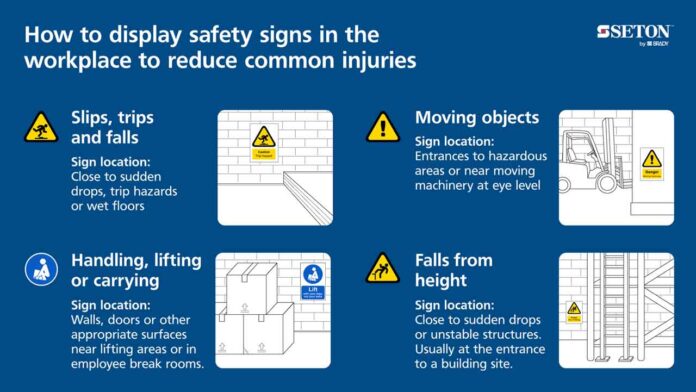Workplace safety is a critical concern for businesses across all industries. Making sure that your employees are safe not only helps prevent workplace injuries but also enhances productivity and morale throughout your organisation.
One of the most effective ways to promote safety is through the use of safety signs in the workplace. These important visual aids serve as constant reminders and indicators of potential hazards, helping to prevent accidents before they occur.
In this article, we’ll delve into the importance of safety signs in the workplace and highlight how they can prevent common injuries and contribute to an overall safer work environment.
The role of safety signs in preventing workplace injuries
According to the Labour Force Survey (LFS), over 560,000 UK workers sustained a non-fatal injury at work in 2022/23. A large portion of these injuries resulted from preventable incidents, such as slips, trips, and falls – which accounted for 32% of all non-fatal injuries.
This magnifies the importance of safety signs since they play a crucial role in mitigating these risks by alerting workers to potential hazards and reinforcing safe workplace practices.
Types of common workplace injuries and relevant safety signs
Let’s look at some safety signs that are important when it comes to the most common workplace injuries.
Slips, trips, and falls:
- Sign type: Hazard sign
- Colour: Yellow
- Location: Close to sudden drops, trip hazards, or wet floors
Slips, trips, and falls are often a huge threat in various work environments, from construction sites to even offices. Yellow hazard signs placed near wet floors, uneven surfaces, or sudden drops can help significantly reduce the likelihood of these accidents occurring.
Handling, lifting, or carrying:
- Sign type: Lift correctly signs
- Colour: Blue
- Location: Near lifting areas or in employee break rooms
Improper lifting techniques can lead to serious injuries for employees. Implement these blue signs to instruct workers on proper lifting methods, and they can be placed in strategic locations to remind employees to use safe lifting practices.
Moving objects:
- Sign type: Danger/Caution sign
- Colour: Yellow
- Location: Entrances to hazardous areas or near moving machinery
Workplaces with moving machinery or vehicles pose significant risks. Use yellow caution signs at entrances to these areas to warn employees to stay alert and follow the right safety protocols.
Falls from height:
- Sign type: Danger – triangular falling hazard sign
- Colour: Yellow
- Location: Close to sudden drops or unstable structures
In industries such as construction, a common workplace injury occurs when employees fall from height. Yellow triangular signs can indicate areas where there’s a risk of falling, prompting workers to take extra precautions.
The benefits of safety signs
There are many benefits to having the right safety signs in your workplace, including things like:
Enhancing awareness
A huge part of safety signage is that it serves as a constant visual reminder of potential hazards, ensuring that safety remains a top priority for employees throughout the workday.
Reducing absenteeism
By preventing injuries, safety signs can help reduce absenteeism caused by workplace accidents. This not only protects employees but also saves businesses money and helps maintain consistent levels of productivity.
Legal compliance
Employers are required by law to provide a safe working environment, and safety signs can be a big part of this. Safety signs help businesses comply with health and safety regulations, thereby avoiding legal issues and potential fines.
—
Safety signs are a fundamental component of workplace safety strategies, and they provide essential information that can prevent accidents, protect employees, and ensure compliance with legal standards.
Do you have the right safety signs in your workplace to effectively prevent accidents?







